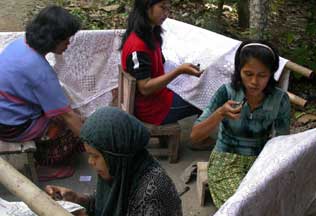Batik Industry Strengthens: Yogyakarta, Central Java
 For hundreds of years, the residents of Wukirsari village in Imogiri, Yogyakarta, have produced fine pieces of batik, passing on the ancient skill from generation to generation. On May 27 last year, the village was devastated when a massive earthquake hit the region. Many residents lost their homes and most of their possessions in the disaster.
For hundreds of years, the residents of Wukirsari village in Imogiri, Yogyakarta, have produced fine pieces of batik, passing on the ancient skill from generation to generation. On May 27 last year, the village was devastated when a massive earthquake hit the region. Many residents lost their homes and most of their possessions in the disaster.
However, the earthquake failed to dampen the local’s spirit, with batik makers quickly working to restore their shattered economy and rebuild their lives.
“We worked in the batik industry before the earthquake, but now we do everything ourselves, including drawing, dyeing and selling pieces of batik,” said Muqoyaroh, 50, head of the Berkah Lestari batik cooperative in Karangkulon hamlet, Wukirsari, a kilometer northeast of the Mataram royal cemetery in Imogiri.
Muqoyaroh said four months after the disaster, approximately 150 batik makers from the Karangkulon, Giriloyo and Cengkehan hamlets decided to set up the cooperative.
He said the drastic change from working in the batik industry to creating their own batik cottage industry required a lot of adjustment.
Thanks to the Dompet Dhuafa charity foundation, a number of villagers were provided with training and passed on the skills to others.
One of the cooperative’s early creations was a 1.2-kilometer batik cloth, which currently holds the record for being the country’s longest piece of batik at the Indonesian Records Museum.
“However, the most important thing is people’s spirit. Thanks to God, residents are able to create batik by hand as part of our cooperative,” said Muqoyaroh.
Khoryatun, 54, said batik making skills had been developed for hundreds of years in the village. At one point, nearly every resident was involved in batik production. To preserve the tradition, a number of children and teenagers are currently being taught the art.
Giarti, a mother of two, said the cooperative uses natural ingredients to produce colors used to dye batik. For example, mango leaves are used to produce light green, teak leaves produce a brownish red color and mahogany tree bark is used to produce brown.
“We are able to get materials to produce the colors we need from the surrounding area,” Giarti said.
To produce bright colors, fabric must be dyed between 15 and 30 times.
“After the dyeing process, the fabric is hung out to dry, but not directly under the sun. It is later dyed and dried several more times until the required color is achieved,” said Giarti.
She said the cooperative is currently trying to find a market niche for their products, with buyers from Australia and Sweden having already shown interest.
The price of a piece of batik varies depending on its motif, colors used and its level of intricacy. Undyed fabric sells for approximately Rp 250,000, while dyed fabric varies in price from Rp 500,000 to Rp 1.5 million (approximately US$165).
Batik fabric is soaked for 24 hours, boiled for an hour, soaked again and then ironed before motifs are sketched on in wax.
After the motif is sketched on, which takes between 10 and 20 days, the fabric is soaked in detergent and then dyed with the desired colors.
“Batik is relatively expensive because it takes a long time to make. We are only able to produce 20 to 50 pieces of batik each month despite the fact our cooperative is made up of hundreds of artisans,” Muqoyaroh said.
Slamet Susanto